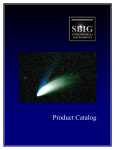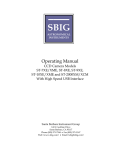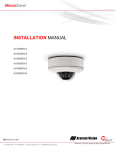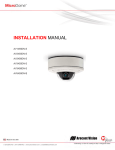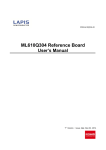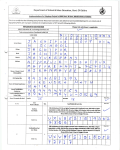Download CFW-8A Color Filter Wheel Manual
Transcript
CFW-8A Color Filter Wheel Manual SBIG - Santa Barbara Instrument Group ©2002 Santa Barbara Instrument Group 147-A Castilian Drive Santa Barbara, CA 93117 Telephone (805) 571-7244 FAX (805) 571-1147 Copyright Notice This manual is copyrighted by Santa Barbara Instrument Group (SBIG). This manual may not be copied in whole or in part. CFW-8A Manual Version 1.4 Printed 2002 ©2002 Santa Barbara Instrument Group 147-A Castilian Drive Santa Barbara, CA 93117 Telephone (805) 571-7244 FAX (805) 571-1147 TABLE OF CONTENTS Introduction ...................................................................................................1 Overview of Taking and Processing Color Images.............................2 Telescope Work.....................................................................................2 Color Image Processing......................................................................3 Hardware Reference....................................................................................4 Making the Electrical Connection ...................................................7 Maintenance of the Color Filter Wheel...........................................12 SBIG CFW-8 Page i SBIG SANTA BARBARA INSTRUMENT GROUP The CFW-8A Color Filter Wheel INTRODUCTION This manual describes Santa Barbara Instrument Group's CFW-8A Color Filter Wheel. This product can be used with CCDOPS or CCDSoftV5 software to facilitate taking and processing of tri-color images with most SBIG cameras, including the ST-4X, ST-5, ST-6, ST-7, ST-8, ST-9 and ST-10 Imaging Cameras. This list may be expanded as we add new models. Many third party software packages also support SBIG products. The Color Filter Wheel is an accessory that mounts on the front of the camera. The filter wheel has five filter positions: Red Filter, Green Filter, Blue Filter, Clear Filter and 1 Clear Aperture position for additional filters of your choice. "Primary" color images are taken through the Red, Green and Blue Filters and the Clear Filter allows ordinary observing without having to refocus. SBIG CFW-8 Page 1 SBIG SANTA BARBARA INSTRUMENT GROUP Overview of Taking and Processing Color Images This section provides an overview of the steps necessary, both at the telescope and in front of the computer, to take and process tri-color images. Telescope Work At the telescope you use the standard CCDOPS software to take sets of three images for each object. The three images represent the Red, Green and Blue primary images. Take these images as you would for monochromatic images except use the filter wheel to select each of the three primary spectral bands. You can take equal duration exposures in the Red, Green, or Blue or match the exposure duration of each primary image to the brightness of the object. Typical ratios of Red : Green : Blue are 1 : 1 : 1.6 to match the exposure to the CCD's sensitivity although accurate color balance should be done for your system with neutral grey objects or "white" G5 type stars. Each of these images should be dark subtracted1 and should be saved with a name that indicates the color of the filter (e.g., M51R, M51G, M51B). Note, however, that different software programs may handle tri-color files differently and the naming convention you use is dictated by your software. If you are using a fast system (low F number) and your images show signs of vignetting (such as a variation in the sky background level) then you should also take flat 1 You may also want to use the other image enhancement features of CCDOPS such as removing cool pixels. In general the three image set should be made to look their best prior to merging the RGB image. SBIG CFW-8 Page 2 SBIG SANTA BARBARA INSTRUMENT GROUP field images and flat field correct your primary images using CCDOPS. Whether you need to take different flat field images for each primary color or not will depend on how different the vignetting pattern is for the different primary images. Typically a single flat field image will suffice. Color Image Processing A complete description of color processing is beyond the scope of this manual. A complete description and step by step instructions may be found in the CCDSoftV5 manual. Different software packages may handle the combining differently, but in general, you register or co-align the primary color images. You select the Red image from the set of three primary images you want to register and the software then loads and displays it. In that image you select a reference star (or pixel) and this rerence star (or pixel) is used to register the Red, Green and Blue images to one another. Once the images have been registered, they are merged together to form a tri-color image and minor adjustments are made to achieve color balance. Third party software packages such as Maxim DL, Adobe Photoshop or Aldus Photostyler are popular programs for combining the three primary images. While these packages tend to be expensive, often times you can find last year's versions at a sharp discount and they really are powerful image processing packages producing the most professional results. SBIG CFW-8 Page 3 SBIG SANTA BARBARA INSTRUMENT GROUP Hardware Reference This section describes the CFW-8A Color Filter Wheel accessory for the ST-4X, ST-5, ST-6, ST-7, ST-8, ST-9 & ST-10 CCD Cameras. It includes instructions on how to install and operate the filter wheel. Attaching to the CCD Camera The CFW-8A is an accessory that allows the user to take images through optical filters. It is installed onto the camera and sits between the Optical Head and the Telescope. CFW-8 CCD Camera Telescope The filter wheel contains a magazine with five filter positions capable 1 of holding standard threaded 1 inch eyepiece filters. SBIG provides 4 four filters for use with the CFW-8A. There is a set of Red, Green and Blue interference filters for color imaging, and a Clear Filter which allows imaging "full spectrum" without having to refocus. No IR blocking filter is needed as the RGB filter have an IR blocking coating. The RGB filters have been selected for a specific bandpass so accurate red, green and blue images can be created. SBIG CFW-8 Page 4 SBIG SANTA BARBARA INSTRUMENT GROUP The filter wheel attaches to other accessories through the universal T-Thread. The front and back of the CFW-8A have female T-Thread receptacles. Using T-Thread makes the CFW-8A a "plug and 1 play" system. You can attach a 1 inch or 2 inch nosepiece draw tube 4 into the front or you can attach an adapter that mates directly to the back of SCTs, replacing the standard Visual Back. Refer to the Appropriate Section below for specific instructions on how to connect the CFW-8A to the various model SBIG Cameras. ST-4X/ST-5 Users ST-4X and ST-5 users slip a TR-4 T-Thread adapter over the camera's nosepiece and screw the CFW-8A into the end of the TR-4 with the T-Thread coupler at the back of the CFW-8A. ST-4X ST-5 CFW-8 TR-4 ST-6 Users ST-6 users mount their camera to the CFW-8A by replacing the ST-6's removable nosepiece with a T-Thread flange. The CFW-8A is then screwed into the T-Thread flange with the T-Thread coupler. Proper clocking of the CFW-8A to the ST-6 is achieved by loosening the three set screws on the edge of the T-Thread flange, rotating the CFW8A, then re-tightening the three set screws. SBIG CFW-8 Page 5 SBIG SANTA BARBARA INSTRUMENT GROUP ST-6 CFW-8 T-Thread Flange ST-7/ST-8/9/10 Users A permanent mounting of the CFW-8A to the ST-7/8/9/10 is accomplished by attaching the CFW8 directly to the face plate of the camera by the following procedure: 1. Remove the ST-7/8/9/10's T-Thread mount held in place with 4 phillips head screws and set the screws aside. [The TThread mount is where the nose piece screws into the camera head. It is a block approximately ¼” thick and shaped like the letter “D” attached to the face plate of the camera. It has three set screws holding an internal ring that has female TThreads]. 2. Remove the cover of the CFW-8A and pull the filter magazine out of the housing. 3. Remove the four rubber hole plugs from the rear of the CFW8A by pushing them through the housing with a small allen tool. Save these in case you decide to later use the CFW-8A with the T-Thread coupler or with a different camera. 4. Using the four 4-40 by 3/16 socket screws provided, attach the CFW-8A to the front of the ST-7/8. Make sure you use the provided screws whose length of 3/16 is required to SBIG CFW-8 Page 6 SBIG SANTA BARBARA INSTRUMENT GROUP thread into the ST-7 front plate without breaking through the blind taps. Alternate temporary attachment of CFW8 to ST-7/8/9/10 ST-7/8/9/10 users may also mount their camera to the CFW8A by unscrewing the camera's T-Thread nosepiece and screwing the Filter wheel onto the camera with an optional male-to-male T-Thread coupler. Proper clocking of the CFW-8A relative to the camera is achieved by loosening three set-screws at the font of the camera rotating the CFW-8A into position then re tightening the 3 set screws. ST-7/8 CFW-8 Making the Electrical Connection The CFW-8A has a cable that comes out the side that needs to connect to your camera electronics. The CFW-8A gets it power and positioning information from the camera thru this connector. If you're using an ST-4X, ST-5 or ST-6 the CFW-8A is supplied with a 15 foot cable that you plug into the AUX port on the camera's CPU. The AUX port is the 9 pin connector adjacent to the COM port you use for communicating with the PC. If you're using an ST-7/8/9/10 the CFW-8A is provided with a short cable that plugs into the camera’s 9-pin telescope connector adjacent to the cable connecting the ST-7/8/9/10 to the PC. SBIG CFW-8 Page 7 SBIG SANTA BARBARA INSTRUMENT GROUP Additionally, the CFW-8A connector has the phone-jack connector that allows you to connect to the telescope for tracking and Self Guiding. If you ever decide to connect the CFW-8A to an ST-4X, ST-5 or ST-6 you can buy a 15 foot 9 pin extension cable to extend the short cable back down to those cameras' CPU. Attaching to the Telescope At the front of the CFW-8A you can attach any T-Thread based adapter that will connect to your telescope, including the nosepiece from your camera. When using a nosepiece to slip the camera and filter wheel assembly into an eyepiece holder, you need to pay careful attention to insure the weight of the filter wheel with the camera attached is held in place with the eyepiece holder's retaining screws. SBIG also sells an optional T-Thread Visual Back Adapter which screws directly onto the back end of the popular Schmidt-Cassegrain telescopes. This makes for a very rigid mounting. After attaching the camera/filter wheel combination to the telescope, you should then drape the Camera's head cable over the fork of the telescope and clip it in place so that the cable doesn't drag on the ground as the telescope rotates. Also avoid hanging the camera head and filter wheel by the cables as this could overly strain the cables. Positioning the Filter Wheel The motorized CFW-8A filter wheel is positioned using commands in the CCDOPS software's Filter menu. The unit does not require calibration like the older CFW-6A and is auto-homing at power-up. You need to tell the CCDOPS software that you are using the CFW8A and this is accomplished by selecting the CFW-8A as the filter SBIG CFW-8 Page 8 SBIG SANTA BARBARA INSTRUMENT GROUP wheel type in the Setup command of the Filter menu. If you have an older version of CCDOPS that does not show the CFW-8A you can still use the CFW-8A by first erasing the FILTER.CFG file in the CCDOPS directory (the software will create a new one for you) then select the CFW-6A type filter wheel in the Setup command. There are individual commands in the Filter menu with hot-keys for positioning the filter wheel. Also the Camera Status window shows which filter is currently in position, and this information is recorded with images when they are captured. You can rename the filters using the Filter Setup command. If you have removed the filter wheel from your camera or removed the filter from the magazine you can select the None command in the Filter menu. The None command doesn't position the filter wheel, it just tells the software that you aren't using a filter at the moment. If you run without filters for a period of time you should use the Filter Setup command to select the "None" type of filter wheel. Remote Shutter Operation with the ST-4X and ST-5 ST-4X and ST-5 users can use the CFW-8A as a remote shutter for taking dark frames. If you cover-up the fifth position in the filter wheel (or any other position for that matter) with some sort of opaque material (a sandwich of aluminum foil between layers of black construction paper works well) you can tell the CCDOPS Version 3 and later software to use that darkened position to cover the CCD for taking dark frames rather than continually asking you to cover and uncover the telescope. Use the Setup command in the Filter menu to tell the CCDOPS software which filter position has been darkened by setting the Dark position item. Select which of the five filter position you want to use for "Light" frames using the positioning commands in the Filter menu SBIG CFW-8 Page 9 SBIG SANTA BARBARA INSTRUMENT GROUP and when it comes to taking a dark frame the software will position the filter wheel at the dark position, take the dark frame, then reposition the filter back to where it was for the light frame, All this without you having to cover the telescope! Vignetting The increased length of the filter wheel assembly will cause vignetting for fast systems (those with low F numbers such as F/3.3). The vignetting will be worse for the ST-8, ST-9 andST-10 with their relatively large CCDs versus the ST-7. Vignetting will show up as a fall off in the sky background at the edges of the field of view. Flat fielding greatly reduces the troublesome effects of vignetting. ST-8/9/10 users should use a 2 inch nosepiece or should connect the CFW-8A to the telescope through the T-Mount directly so as to 1 avoid vignetting caused by the 1 inch nosepieces. 4 Selection of Color Filters SBIG color filters include an infrared blocking coating so that a separate IR blocking filter is not needed. The filters used in the SBIG filter wheel have been chosen to optimize the accuracy of the colors produced by the tri-color software. The passbands of each filter are summarized in the table below: Color Filter Passbands SBIG CFW-8 Filter Passband (nm) Red 612-670 Green 488-574 Blue 392-508 Page 10 SBIG SANTA BARBARA INSTRUMENT GROUP The filters are custom filters designed specifically for SBIG cameras. Dichroic filters were chosen over absorption filters for three reasons. First of all, they have high transmission in the passband region. Second, a sharp transition can be obtained in the region around 496 nm. And last, they are all deposited on a sheet of glass of the same thickness, eliminating focus shifts due to varying filter thickness. An infrared blocking coating is applied to these filters to eliminate spectral leaks in the infrared where the CCD has high sensitivity. These bands would be severely contaminated if these leaks were not blocked. Colored plastic filters also have severe red leaks beyond the visible spectral range, so one should particularly avoid those. The sharp transition between the blue and green region is necessary for proper color rendition of emission sources. The 500 nm oxygen line is blue-green in color, and so must pass through both blue and green filters. The hydrogen-beta line at 486 nm is very blue, and must be rejected by the green filter. The green filter will pass less than 10% of this line. Hints for the User Be aware that color imaging is substantially more difficult than using the CCD unfiltered. Whereas before, you only needed to take one image you now need to take three, and each one needs to be about 4 times as long since only a portion of the total spectral range is passed by each filter. This aggravates tracking problems, which are also more pronounced due to the requirement of registering three images. Hot pixels and cosmic ray hits are more objectionable since they become strongly colored in the final image (the hot pixel remove utility in CCDOPS should be used). In spite of all this, you will find that even subtle colors present in galactic scenes enhance the SBIG CFW-8 Page 11 SBIG SANTA BARBARA INSTRUMENT GROUP image noticeably, and emission nebulas take on beautiful hues of blue, blue-green and red. Star colors are dramatically enhanced, and impart a three dimensional aspect to the image. We have endeavored to create a product that enables true color pictures of deep sky objects to be produced. We have made certain philosophical decisions with which some may disagree. For example, if we traveled in space to where we were quite close to the Dumbbell Nebula it would appear to be a large gray mass devoid of color, buried in mostly white stars. If we traveled to other galaxies they would be no brighter, in general, than our Milky Way. Many extended objects, such as the Horsehead Nebula, have very low contrast relative to the sky background, often less than 10%, and would never stand out sharply. The images you see on the computer screen are not true, in the general sense, being considerably enhanced in brightness and contrast over the actual object. We have carried this philosophy to the way our program displays star images; stars saturate to the proper color, not white. Your eye would see them differently but less accurately! We find the result very pleasing, but please give us your impression. Maintenance of the Color Filter Wheel The surface of the filters may be safely cleaned with Isopropyl or Methyl alcohol and cotton swabs. Use a gentle circular motion, using several swabs until the surface is clean. The machined parts may be cleaned by rubbing with a soft cloth. A small amount of lubricant can be applied to the magazine axle should the unit start to chatter but please do so sparingly. It really is a light duty interface. If some part of the CFW-8A assembly is damaged, replacement parts may be obtained from Santa Barbara Instrument Group. Disassembly of the CFW-8A is rather straight-forward. You can remove the front cover by removing the six screws that hold it in SBIG CFW-8 Page 12 SBIG SANTA BARBARA INSTRUMENT GROUP place. Once removed, the front cover comes completely free of the CFW-8A allowing access to the filter magazine. The filter magazine can be removed by lifting the magazine straight-up out of the back housing by one-quarter inch then tilting away from the motor and removed completely from the housing. Upon inspection you will notice that the filter magazine has a top and a bottom. The filters screw in from the bottom and the top has the optical alignment pins. As viewed from the top the filter positions are shown in the figure below, noting the position of the double-pinned position adjacent to position 3: 1 2 5 3 4 Top View of the Filter Magazine The filter wheel is reassembled in the reverse process. Rotate the filter magazine so that the alignment pins straddle to either side of the motor then tilt the magazine into place and drop it into the back of the housing. Be careful to not bend the axle in the process and also make sure the magazine is inserted with the filters down towards the camera) and the alignment pins up. The filter wheel will be held in place against the motor and can be leveled to make installing the front cover easier. Though it SBIG CFW-8 Page 13 SBIG SANTA BARBARA INSTRUMENT GROUP should not be necessary to do so you may loosen the two screws that hold the motor in place. If you do so you'll need to remove the motor cover from the font cover so that you can readjust the tension of the motor against the magazine. Adjust the tension till the magazine does not rotate freely but not so tight as to put strain on the motor that would be accompanied by irregular movement of the magazine or soft "clicking" sounds. You do not need to worry about the angular orientation of the magazine as the unit will auto home itself upon power-up. SBIG CFW-8 Page 14


















